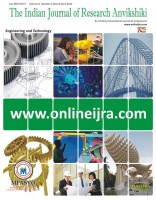Research Paper

A REVIEW ON METALLURGY OF WELDING OF CAST IRON AND EFFECT OF PREHEAT
Author: *PRADESHI RAM, ** S.P. TEWARI, *** JYOTI PRAKASH
* M.Tech, Mechanical Engineering Department, Institute of Technology, Banaras Hindu University, Varanasi, India
**Professor, Mechanical Engineering Department, Institute of Technology, Banaras Hindu University, Varanasi, India
*** Senior Research Scholar, Mechanical Engineering Department, Institute of Technology, Banaras Hindu University, Varanasi, India
*All correspondence with this mail-id pradeepji59@gmail.com
{PUBLISHED RESEARCH PAPER}
Download PDF
ABSTRACT
Most of the welding of cast iron is repair welding. Carbon pickup and resulting cracks are the main concerns when welding CI. The casting process is never perfect, especially when dealing with large components. Instead of scrapping defective castings, they can often be repaired by welding. Naturally, the very high carbon concentration of typical CIs causes difficulties by introducing brittle martensite in the heat-affected zone of weld. It is therefore necessary to preheat to a temperature of 450 °C, followed by slow cooling after welding, to avoid cracking. The effect of preheat temperature on the microstructure obtained in the heat-affected zone HAZ and the carbide zone in the weld metal adjacent to HAZ has been studied in multipass welds for the as ductile cast irons. The welding was carried out with manual shielded metal arc welding using ENiFe–CI filler metal. Ultrasonic, microhardness distribution, tensile and impact tests were conducted to evaluate the quality of welded joints.